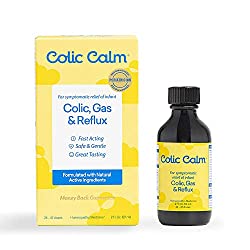There are a number of colic remedies available. You can choose from calming techniques to a soothing massage, homeopathic medicines and so forth.
It is important to choose a remedy that is natural and completely safe to calm your colic baby.
Unfortunately, what works for one baby does not work for all. Therefore, finding the RIGHT colic remedy can be very challenging. You need to try a number of things.
Ideally, begin with the least intrusive being the 5 “S”s and massage. If these do not work then purchase products that are to be ingested.
However, before starting to look for any colic remedy it is important to have a proper diagnosis.
Babies can often present as colic when in fact there may be another medical condition going on. Work with your pediatrician or naturopathic doctor to be sure.
The goal of any colic remedy is to soothe the baby.
However, before you begin to treat your baby’s colic make sure to rule out any of the normally seen signs of crying.
For example, is your baby hungry? Look at their mouth and head.
Is their mouth open?
Are they moving their head side-to-side?
These are often signs of hunger. Maybe your baby is tired. Take a look at their eyes.
Are their eyes opening and closing?
Are they yawning?
Maybe they’re having indigestion or need a diaper change.
So before starting anything else address these things first and if none of them relieve the crying and fussiness then start colic remedies.
Colic Definition and Causes in Babies

Caring for a newborn baby is challenging at the best of times, but when your baby won’t stop crying it can be very frightening.
Most parents learn the telltale signs of communication with their children fairly quickly.
They know the cry of hunger, of a wet diaper, being overtired and so forth. For each of these, they know exactly the remedy to soothe their little one and before no time their bundle of joy is happy once again.
But what about the child that does not respond to your efforts?
You’ve tried everything, you have not slept in what feels like months and you feel hopeless. Your baby is crying incessantly for no reason.
You’ve made sure that they are fed, dry, comforted and so on, but nothing works. Your baby could be colic.
So what is colic and what causes colic in babies?
Colic Definition
The definition of colic follows the rule of three: 3-by-3-by-3. It’s really easy to remember.
Outbursts of crying that last more than 3 hours per day, more than 3 days per week, and for more than 3 weeks.
Now keep in mind we are talking about crying that is not related to being hungry, tired, or wet. And more importantly, this is an overall healthy child that we are referring to.
Babies with known illnesses will also cry and fuss a lot. Therefore, it is really important that you consult with your doctor to rule out any other possibilities.
So how long is all of this going to last?
According to WebMD “colic usually starts at about 2 weeks of age in a full-term infant (or later in a premature infant)…[and] almost always goes away by 3 or 4 months of age.
Causes of Colic in Babies
There are many theories of the cause, however, there is not one that is definitive. So trying to hunt down the exact source can be extremely challenging.
Working with a Naturopathic Doctor can be helpful as they will be able to provide natural and holistic remedies, like homeopathy, rule out digestive complaints and provide techniques for soothing and comforting.
Common Colic Cause Theories
- Digestive Problems: this can be due to an intolerance to milk or lactose much like many adults experience. It stems from not having the proper enzyme, lactase, in the body to break down the lactose (known as lactose intolerance). In such cases, it can lead to abdominal discomfort and excessive gas – both of which are painful. Alternatively, infants can have the same symptoms of having too much milk inside the intestine. It is not that they don’t have the enzyme, but rather that they are not able to break down the lactose fast enough.
- Heartburn: again much like adults can have heartburn so too can your baby. This is caused by the overproduction of stomach acid that rises back up (known as acid reflux).
- Parental Anxiousness: babies have an innate ability to sense everything around them. If you are nervous or tense when picking up your child they can sense it and in turn, it triggers a distress signal in their brain.
- Other Theories: this includes an immature digestive system, increased hormones, hypersensitivity to any type of stimuli, temperament, and an immature nervous system. Read more about it at WebMD.
- Migraine Headaches: Most recently a new study has revealed that colic could, in fact, be due to your baby suffering from migraine headaches. USA Today reported on the study released April 16, 2013, in the Journal of the American Medical Association (Source USA Today). This forces us to re-think the definition of colic in babies.
If your baby is colic there are remedies that can help. Lactase drops, gripe water, tummy waistbands, anti-colic bottles and so forth.
Colic Remedies that Work
5 “S”s to Calm Your Baby
The 5 “S”s is a method developed by Dr. Harvey Karp. He is a leading authority on calming fussy babies and the author of “The “Happiest Baby on the Block“.


He talks about the importance of imitating the womb. Logically it makes great sense as this is where your baby has known comfort for nine months.
So bringing the womb experience to the outside world for your baby can be just the right remedy. Below is a summary of this method, but for full details watch Dr. Karp in action…just click here.
The 5 “S” method consists of:
- Swaddling – is a method of wrapping your baby in a swaddling cloth. This restrictive nature when done right is calming for the baby. Dr. Karp talks about the importance of proper swaddling. He emphasizes the need for the arms to be a little snug with some give in the hip area. Make sure that it is not too tight and not too loose.
- Side Stomach Position – simply holding your baby in a side position in your arms can be very soothing. However, this technique is to be used only for calming the baby and not as a sleeping position. Make sure that the baby’s head is comfortably placed in your hand always ensuring that you have a hold on the head and neck.
- Shushing – is a noise that mimics the sound inside of the womb. Some parents even play a womb sounds DVD to settle their baby to sleep.
- Swinging or motion – are both ways that you can move your baby. Some prefer quicker movements, while others like very slow rocking. Try different motions to learn what your baby likes the best. Always remember, to hold the head and NEVER shake your baby.
- Sucking – is very soothing and often helps to calm your baby almost immediately. Using a pacifier, finger, or nipple all will have the same effect.
Touch and Massage
Most babies love to be touched. And “research suggests that infant massage has enormous benefits for helping babies grow and thrive” (Source: What to Expect).
They find it very calming and it is a great way to bond with your child. Be gentle and watch your baby for clues about what he or she likes.
You will quickly learn to read these signs that make the massage more pleasurable. Here’s a great slideshow from the Baby Center on “How to Massage Your Baby“.
How can infant massage benefit your little one? It can help ease your baby’s tummy troubles and teething pains, boost his muscle development, calm him when he’s fussy, and soothe him to sleep. But the advantages don’t stop there: All that stroking and touching make it easier for you to bond with your newborn. What’s more, giving your baby a massage can help you find your own inner Zen, too (and who can argue with that?).
Colic Calm and Other Gripe Water Solutions
Colic Calm is an all-natural homeopathic FDA approved solution for colic. It is safe and provides instant relief for your baby. Watch the video below to see how quickly the baby calms.


There are many other remedies available. Some helpful hints when trying to make a selection:
- Safe
- Natural
- Easy to administer
- FDA approved
- Can be used anywhere, any time
BE ADVISED: We do not condone or recommend products containing simethicone.
Choose Anti-Colic Baby Bottles
If you are going to bottle-feed your baby (and many moms do that), you should look for bottles that have anti-colic features.
Philips is one of the companies on the market that produces high quality, durable baby bottles with special anti-colic features.
Their Avent line of baby bottles are popular among moms because it not only helps your baby feed, but it also reduces or eliminates colic completely.
There are other brands like Dr. Brown, Medella, Comotomo, Tommee Tippee, that all produce good quality baby bottles too.
Read about the best baby bottles for breastfed, preemies & colic babies here.
What’s important is that you do thorough research before settling on a particular brand. You can do this by reading through product reviews on the bottle, what it solves and where it fails, as well as Youtube videos from experts and manufacturers.
This will not only help you learn more about how your baby feeds, but it will also help you make an informed decision.
If you can go through all these steps, then you are in luck as we already have a big guide on this topic on the BusyMomOnTheGo blog. You can read the guide to the best baby bottles for reflux here.
Check out some other picks from Amazon also:

